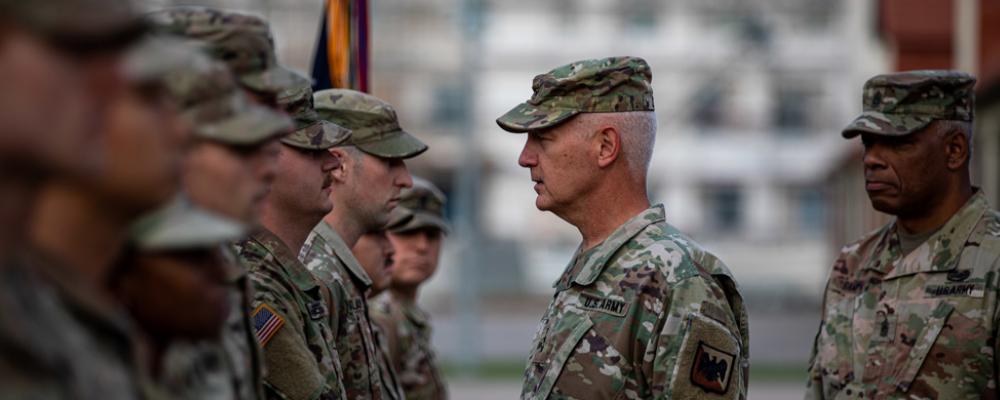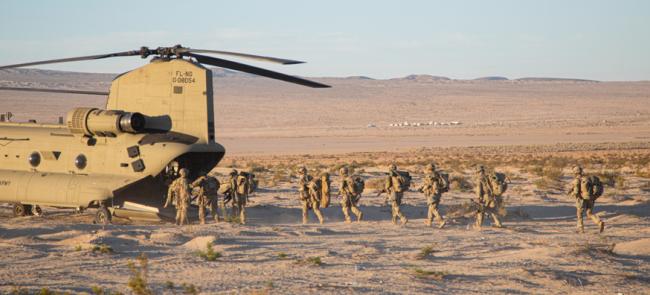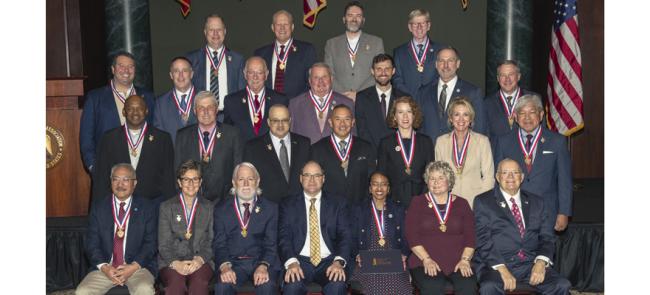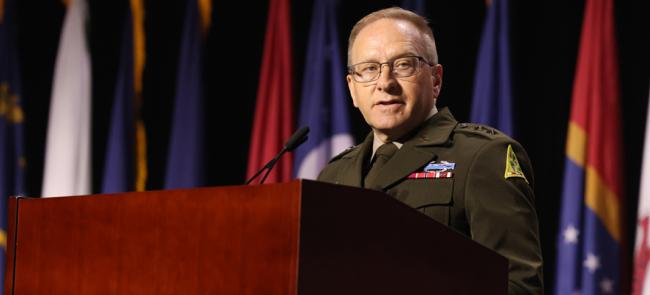
A Conversation with Lt. Gen. Jon A. Jensen
Lt. Gen. Jon A. Jensen suddenly has some new challenges.
Entering his third year in charge of the development and implementation of federal programs and policies affecting the Army National Guard, he already had a full plate, principally modernization, a significant endeavor involving more than just equipment.
But now he has to devote more resources to filling his ranks and potentially pick up more missions while the active-component struggles with even greater recruiting struggles.
One answer, Jensen says, to the question of how to attract more enlistees is to do a better job of telling the Army National Guard story.
He’s convinced that young people today are interested in the personal growth opportunities and rewards that come from being a citizen-soldier; they just need to know such opportunities exist.
Jensen sat down with NATIONAL GUARD last month in his office at the Herbert R. Temple Jr. Readiness Center in Arlington, Virginia. The conversation covered challenges new and old, and the impact of recent developments.
Many Army National Guard combat units have long been saddled with less than the Army’s top equipment. But that appears to be changing. Attack reconnaissance battalions are beginning to receive the AH-64E Apache attack helicopter. More armored brigade combat teams will soon be getting brand-new tanks. And two artillery battalions are in Army plans for Extended Range Cannon Artillery. What does this say about the Army National Guard’s role in future fights?
What that really says is that we are going to be involved in the future operations of the Army. Whether we call that an operational reserve or if we have a name for that, the Army’s plan is to have COMPO2 [the Army National Guard] part of the Total Army. We’re going to continue to be asked to support the GFMAP [Global Force Management Allocation Plan]. We’re going to be asked to continue to support early deploying units. So I think this is a really exciting thing for our soldiers who want to serve in relevant units, conducting relevant missions in support of our country.
In our conversation two years ago, you said that modernization isn’t just about equipment. One of the areas you mentioned was the shift from brigade-centric to division-centric force. How is that transition going?
I think the transition is going very well. All of our adjutants general are on board with this. And that’s really what the first step was, creating relationships between states that have division headquarters and the other states that don’t. As we were creating these relationships, creating these lines of communication, allowing our adjutants general to really form those in a way it best serves that region and those group of states. We’re a long ways down that road.
Now, we have division formations. Our division TAC [tactical command post], for example, from the 40th Infantry Division, went to Joint Readiness Training Center recently [at Fort Polk, Louisiana] and helped do mission command over their infantry brigade combat team, and we have other examples of that. We’re having divisions now being pushed down to the brigade level and providing mission command over that formation. Previously, our division headquarters were operating separately from the rest of the division, so I’m really excited about those relationships that we’re creating there.
Plans were announced recently to reorganize an Army National Guard division along the Army’s penetration division concept, which is a very heavy formation capable of breaching prepared heavy defenses. How far along is this effort?
In concept, I think it’s down the road pretty far. We had to make change in one structure, in terms that the Army decided they wanted a little bit different structure. And we have another name for it now. I’m really excited about that. It’s beyond the 34th Infantry Division. Most of the units that are aligned with this division aren’t from Minnesota and Iowa. But this division is very high on the Army’s modernization plans. We’re really excited to see how far that’s going to go. And where we’re going to align that division initially, probably to Europe, so we’re watching Europe very closely. And a potential mission not just for that division, but all of Army Guard forces in Europe.
Absolutely, we need to do a better job of getting people promoted on time.
Are you anticipating end strength and force structure changes? What areas of force structure are you most concerned with preserving?
End strength is our No. 1 mission. Getting to our end strength as Congress and the Army establishes for us is always my first objective every year. Like every other service in the Department of Defense, we have recruiting challenges this year. So we are doubling down on that really focused on end strength, ensuring all of our leadership are positively encouraging our recruiters and retention NCOs to get to the mission.
Our ability to meet end strength will have force structure implications down the road. If we show the Army that we can meet the assigned end strength, then we’ll maintain the current continue force structure we have as it relates to a number. If we indicate to the Army that we can’t do that, they’ll look to make changes. Now, there’s already planned changes in force structure as we go through modernization. For example, new units, units that convert will all be part of this. So there will be force structure changes in the Army Guard regardless of what happens with end strength.
Do you see any trends in those changes?
Yes, I do. Again, it’s aligned to the division headquarters or the division as the decisive action echelon. That’s No. 1. And it’s all towards what’s the Army going to look like in 2030. And what’s the Army going to be on ground by 2040. It’s all moving toward those two key dates.
The final fiscal 2022 National Defense Appropriations Act directs the secretary of the Army to provide a report to Congress on which multi-domain operations capabilities can be incorporated into the Army National Guard. What will MDO mean for the Army National Guard? And how might multi-domain operations benefit domestic response?
I think as it relates to what it will mean, again, it gets back to this relevant mission. Relevant force structure, relevant mission, which I believe our soldiers sign up to be a part of. The Army is really looking at the structure of multi-domain task forces and what their contribution to multi-domain operations is going to be.
We’re really excited and we believe we are going to be a part of that multi-domain task force going forward. This is all related to becoming a more modern force — organization, equipment, approaches, doctrine. What’s it going to mean as it relates to operations here domestically? Really, no change. We’re going to be able to accomplish our state mission because we can first and foremost meet our Title 10 responsibilities — fighting in our nation’s war as part of the Total Army, as part of the Joint Force. If we can do that, then we can do anything that we need to do domestically. And I think we really showed that over the last two years.
We’ve been able to meet every need from our governors. As we move down the path of modernization and our ability to do the war fight, I think all of that will still be able to be applied into our domestic operations. Whether that’s responding to wildfires or responding to hurricanes, COVID, other pandemics, those type of missions.
The Army National Guard can maintain units at less cost than the active component. In light of the significant financial resources the Army needs to achieve its equipment modernization priorities, do service leaders consider the National Guard “value proposition” when determining force structure or end strength?
Absolutely. My two years as the director of the Army Guard, I served with General [James C.] McConville, the chief of staff of the Army, and he has been very adamant, before I came on as the director, but certainly during my time as the director, that COMPO2 and COMPO3 are going to be part of the modernization efforts of the Army, and were not going to be at the end of the line.
We’re going to modernize along with COMPO1. So there will always be mix of COMPO1, 2 and 3 along every line of modernization. So, yes, absolutely. I feel that they value our contribution, but more importantly, I think they rely on our contributions to meet the mission that the Army has in front of them.
As we go down the path of modernization, what the true cost of modernization is going to be, I think what we’re going to see is additional capabilities leave COMPO1 and come to COMPO2 and 3 because of that value proposition.
I know you get out and visit Army National Guard. What are commanders and soldiers sharing with you about the force and its utilization?
I think No. 1, what they want is predictability. I think we are in a really good place with the ReARMM [the Regionally Aligned Readiness and Modernization Model], the new readiness model for the Army. With ReARMM, I think we can provide predictability. And we are going to provide predictability to allow soldiers an idea of what they need to focus on in a given period of time. Whether that’s a train-up to deploy, whether that’s actual deployment or during the modernization phase, predictability is No. 1.
I think the second piece our soldiers demand gets back to General [Daniel R.] Hokanson [chief of the National Guard Bureau] and General McConville’s pledge of people first. We’re paying our soldiers on time, we’re getting them promoted, they’re getting opportunities to further themselves as it relates to schools. And back to that the idea of relevant force structures and relevant missions. They want to contribute.
NGAUS is hearing that many officers are experiencing increasing wait times in the federal recognition of their state promotions. What are you hearing?
Yes, we have heard that and worked that very diligently here in the building. Quite frankly, we had a software problem that we weren’t able to modernize as quickly as we needed to. And it did slow that system down. So we are actively working with the states on that topic. I understand the importance of promotions to our officers, NCO corps and enlisted soldiers. Absolutely, we need to do a better job of getting people promoted on time.
Many Guard leaders say one of the biggest challenges facing the force is a shortage of full-time positions. At 16% of its end strength, the Army National Guard has the lowest FTS in the reserve components. Are you wanting to pursue more full-time support?
Absolutely. Being a former adjutant general, I lived that and saw that every day. I truly believe full-time manning does lead us to more ready units. As the Army looks at the Army Guard moving into more early-deploying unit opportunities, I think we’re going to have to increase full-time manning in those units to make sure that we can meet the readiness rates that that additional obligation is going to need. I fully support what the adjutants general have laid out there.
A lot a people say young men and women today don't have the propensity to serve. I don't agree with that.
With training days being such a valuable commodity in the Army National Guard, what is being done to ensure those days are used efficiently, rather than filled with requirements unrelated to a unit’s wartime mission?
I think we’re really back at a transition point. As we’ve left supporting our governors in COVID-19 response operations, I think we’re able to provide that tactical approach and focus to our units. As it relates to that focused training, we’re really relying on commanders to do that. At this level, we don’t direct training. That’s from FORSCOM [Army Forces Command] through our adjutants general down to their tactical commanders. I think what we’re going to see as we transition out of this high rate of usage, related to COVID-19, I think you are going to see us returning back to units that are building readiness on a monthly basis and units really focused to that readiness culture again.
Most of the services are having difficulty recruiting this year. Army leaders say they are in a “war for talent.” What new tactics will the Army National Guard employ to attempt to bolster the number of new recruits?
There is a lot of focus on that as we close down ’22 and move into ’23. I would say it’s along three lines here.
The first line is being focused on recruiters as the recruiters are the center of gravity for this effort. A couple of things we are going to do for them next year; first of all, we’re going to provide a master training pilot. We are going to put a master trainer in every state, a former successful recruiter who can serve as a mentor and a trainer directly to each and every one of our recruiters in their state. We’ve seen some really good success with our recruiter incentive program where recruiters are paid to do more than just their minimal mission. We’re looking at continuing that in ’23.
As it relates to the potential enlistees themselves, one thing we are working with is a Total Army approach — redefining the quality of soldier. Our soldiers today are different that they were 20 years ago because of changes in society and how we approach medical care, things like that. We’re really looking at how we define a quality soldier nowadays. Those soldiers that we do enlist, we’ve got a future soldier prep course lined up for some of them that may need some additional assistance to ensure they are successful, especially during that early entry training piece.
Then, we are looking at the prior-service market. We have a prior- service Army integration course that we have teed up for the Army that we’re hoping they will approve. What this allows is prior service members in the Navy and Air Force, for example, to come join the National Guard and not have to go all the way back to basic training. It’s a significantly smaller course looking at how do we take that prior service member and integrate them into the Army and specifically, into the Army National Guard.
As well, we have to fully fund our recruiting enterprise. What are we doing as it relates to ADOS [active duty for operational support] to support our recruiters so they can focus on recruiting and not driving potential enlistees to the MEPS [Military Entrance Processing Station] and things like that. Then, obviously, what’s always important is the marketing effort. Not at a national level, but how do we do regional and state-specific marketing. Those are really five to seven areas that we’re really going to focus on next year.
Part of it is telling your story. We hear a lot a people say our young men and women don’t have the propensity to serve. I don’t agree with that. I think they do want to serve their community, their state and their nation. But we haven’t done a very good job of connecting with those young men and women by showing them that there is a way for them to contribute through military service. We’ve got to really focus on that. I think our communication piece to young men and women is going to be really, really important as we continue in the 21st century.
Army leaders have indicated that the active component may end the fiscal year roughly 20,000 troops below their original budgeted end strength and drop another 20,000 soldiers next year. They’ve said they will have to rely more on the “mobilized reserve-component soldiers to meet operational demands.” Where might the Army National Guard see more utilization?
We’re already very active in Southwest Asia. As you look at the geographic combatant commands, that’s the No. 1 place where we send soldiers right now. Roughly, we’ve got 29,000 soldiers on Title 10 status across the globe. The majority of them are in CENTCOM. Following that is NORTHCOM. Then, I think the two areas we are going to see growth, potentially, is in Europe, based on the security environment in Europe, and then INDOPACOM. As our national security focus and priority has shifted to INDOPACOM, I think it’s natural that Army National Guard soldiers begin shifting in that direction as well.
The Army National Guard has provided some equipment to Ukraine. M113 armored personnel carriers are one example. How will this equipment be replaced?
The Army strategy that we’re a part of, and fully support, is that we’re not going to buy new old stuff. That this needs to be part of our modernization effort, as some of these older pieces of equipment which are still very effective as we’ve seen in the hands of Ukrainian armed forces. But as those things get moved overseas that we’re going to replace them with new stuff.
Senior leaders watch current conflicts for lessons learned. What are the lessons learned for Army National Guard officers from the conflict in Ukraine?
I think there are two important ones. First of all, it’s the value of the State Partnership Program. When you look at the long history of that relationship between California and Ukraine, and you look how California has helped coach them along, partnered along with them. It really shows the value of that relationship.
The second part of that would be how we can we contribute as part of a deployment. The Joint Multinational Training Group-Ukraine, currently that mission was the 53rd IBCT out of Florida. And you can just see their contribution to the readiness of the Ukraine armed forces. We are in the process of that transition right now to the 27th IBCT out of New York. It’s a strong statement about how our Army National Guard not only improves the readiness of our own units when we deploy, but how we also improve the readiness of our partners and our allies when we deploy.
What have you noted about the conflict on the ground? Some observers have noted the difference the Ukrainian’s emphasis on developing an NCO corps has made when facing the Russians, who rely on the old Soviet system, which relies on overwhelming numbers and firepower rather than tactical leadership.
The advantage the United States Army has over all of our competitors is our NCO corps. When we professionalized our NCO corps and began trusting our NCO corps back in the very beginnings of our Army, it made our Army different. You can see that impact across the globe in our allies and in our partners.
AT A GLANCE
Lt. Gen. Jon A. Jensen
BORN: Jon A. Jensen, 1963 (Council Bluffs, Iowa)
FAMILY: Wife (Cindy), three children
EDUCATION: Northwest Missouri State University, Maryville,
Mo., B.S. Finance and Business Economics, 1986; U.S. Army
Command and General Staff College, Fort Leavenworth,
Kan., M.A. Military Arts and Sciences; U.S. Army War College,
Carlisle, Pa., M.A. Strategic Studies
COMMISIONING SOURCE: Officer Candidate School
MILITARY SERVICE: Iowa Army National Guard, 1982- 2002;
Minnesota Army National Guard, 2002-present
PREVIOUS ASSIGNMENTS: Adjutant General of Minnesota, St.
Paul., Minn., 2017-2020; Commander, 34th Infantry Division, St.
Paul, Minn., and (dual-hatted) Deputy Commander and Army
Reserve Component Integration Advisor, U.S. Army Africa and
Southern European Task Force, U.S. Africa Command, Vicenza,
Italy, 2017; Commander, 1st Armored Brigade Combat Team,
34th Infantry Division, Bloomington, Minn., 2012-2014
OVERSEAS OPERATIONS: Desert Spring (Kuwait), Joint Forge
(Bosnia-Herzegovina) and Iraqi Freedom (twice)
ALSO NOTABLE: Began military career as an enlisted combat
medic, advancing to staff sergeant before attending OCS in
1989. Served on the NGAUS board of directors as the TAG
representative for Area V from 2019 until taking over as Army
Guard director in 2020.



